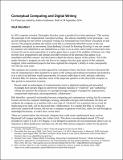Conceptual Computing and Digital Writing
Author(s)
Montfort, Nick
DownloadConceptual_Computing_and_Digital_Writing.pdf (121.9Kb)
OPEN_ACCESS_POLICY
Open Access Policy
Creative Commons Attribution-Noncommercial-Share Alike
Terms of use
Metadata
Show full item recordAbstract
In 1952 computer scientist Christopher Strachey wrote a parodical love letter generator. This system, the prototype of all computational conceptual writing – the almost completely secret prototype – was up and running not only before conceptual writing was formulated but even before conceptual art had arrived. The program predates the earliest work that is consistently identified as part of the (yet unnamed) conceptual art movement, Rauschenberg’s Erased De Kooning Drawing. It was not created by someone who identified or was identified as a writer, or as an artist, and it seems to have been seen as more the server-room equivalent of a parlor game than as a part of the tradition of literary arts. Only recently have programmers and scholars provided versions of the generator that appear in an installation and Web contexts and discussed in depth the literary aspects of the system. All of this makes Strachey’s program not only the first in its category but also quite typical of the scattered, marginal, often overlooked projects that have explored the computer’s ability to write conceptually over the last sixty years.
Date issued
2018Department
Massachusetts Institute of Technology. Program in Comparative Media Studies/WritingJournal
Postscript: Writing after Conceptual Art
Publisher
University of Toronto Press
Citation
Montfort, Nick. "Conceptual Computing and Digital Writing." Postscript: Writing after Conceptual Art, edited by Andrea Andersson, University of Toronto Press, 2018, 197-210.
Version: Author's final manuscript